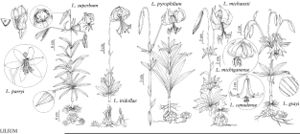Lilium michauxii
in J. Lamarck et al., Encycl., suppl. 3: 457. 1814.
Bulbs chunky, 2–3.5 × 2.5–4.4 cm, 0.6–0.9 times taller than long, 2 years’ growth evident; scales ± loose, unsegmented or rarely 1–2-segmented, longest 1.5–2.6 cm; stem roots present or rarely absent, often numerous. Stems to 1 m. Buds ± triangular in cross section. Leaves in 2–4(–5) whorls or partial whorls, 3–10(–14) leaves per whorl, ± horizontal or somewhat ascending, especially distal leaves, 3.6–11.1 × 1.5–3.8 cm, 1.8–5.1 times longer than wide; blade noticeably pale abaxially, oblanceolate, sometimes slightly or narrowly so, or occasionally obovate, texture noticeably fleshy, margins barely to strongly undulate, apex acuminate or sometimes acute, especially in distal leaves; veins and margins ± smooth abaxially. Inflorescences umbellate, 1–4-flowered. Flowers pendent, sweetly and strongly fragrant; perianth Turk’s-cap-shaped; sepals and petals reflexed 1/4–1/3 along length from base, pale green then orange proximally, burnt orange-red distally, usually with numerous fine, dark maroon spots, dull abaxially, not distinctly clawed; sepals with 2 parallel, often faint abaxial ridges, 5.7–9.7 × 1.4–2.2 cm; petals 5.7–9.2 × 1.8–2.9 cm; stamens strongly exserted; filaments parallel along most of length, then widely spreading, diverging 14°–25° from axis; anthers purple, 1–2.2 cm; pollen rust or sometimes rust-brown; pistil 5–7.6 cm; ovary 1.4–2.5 cm; style very pale, often spotted purple; pedicel 9.3–17.4 cm. Capsules often longitudinally winged, 2.4–5.6 × 1.4–2.3 cm, 1.5–3.7 times longer than wide. Seeds not counted. 2n = 24.
Phenology: Flowering summer (Jul–mid Aug).
Habitat: Roadsides, pine-oak or open rich woods, bluffs
Elevation: 0–1600 m
Distribution

Ala., Fla., Ga., La., Miss., N.C., S.C., Tenn., Tex., Va., W.Va.
Discussion
This is the only fragrant native lily east of the Rocky Mountains. The Carolina lily occurs in well-drained soils, while the three closely related congeners with which it is sympatric, Lilium superbum, L. iridollae, and L. pyrophilum, occur in either wetlands or moist woods. Where it occurs with L. superbum, as it often does along roadsides, L. superbum grows in the adjacent depressions and L. michauxii on the bank. Among its close relatives, its small stature, broad petals, and consistently oblanceolate leaves with undulate margins and acuminate tips are diagnostic. In these features it rather resembles several of the western taxa, especially smaller plants of L. rubescens; vegetative or fruiting herbarium material of the two can be confused. In L. michauxii the leaves are noticeably fleshy and pale abaxially, relatively few in number, and, perhaps because whorls are also few (commonly 2–4), the leaves seem concentrated near the middle of the stem.
This species is less common in the southwestern portion of its range, where it is sometimes encountered in vegetative form in shaded settings that preclude rapid growth and flowering.
Like the other southeastern pendent-flowered lilies, the Carolina lily is pollinated by large swallowtail butterflies including the eastern tiger (Papilio glaucus Linnaeus, family Papilionidae).
Selected References
None.
